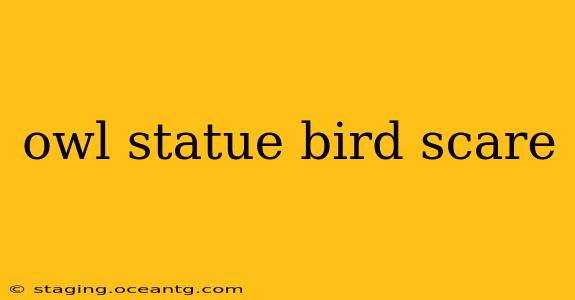Owls are majestic creatures, but their presence can be unwelcome in certain situations. Farmers and gardeners often seek ways to deter birds from damaging crops or gardens, and owl statues are frequently marketed as a simple, non-lethal solution. But do these owl statue bird scarers actually work? Let's delve into the effectiveness of owl statues as bird deterrents, exploring the science behind their supposed efficacy, and examining the factors that influence their success.
How Effective Are Owl Statues as Bird Scarers?
The effectiveness of owl statues as bird scarers is a complex issue. While some people report success, others find them completely ineffective. The reality is that their success rate is highly variable and depends on several factors. Birds, particularly those who have lived in an area for a while, quickly learn to recognize that an owl statue is not a real threat. The novelty wears off, and they'll resume their activities.
What Factors Affect the Success of Owl Statues?
Several factors influence whether an owl statue will deter birds:
-
Bird Species: Different bird species have varying levels of intelligence and fear responses. Some birds are more easily scared than others. Highly intelligent birds like crows are unlikely to be fooled by a stationary statue.
-
Statue Placement: The placement of the owl statue is crucial. It should be visible and strategically placed near areas where birds are causing problems. Rotating the statue's position periodically can help maintain its effectiveness, as birds might become accustomed to a static position.
-
Statue Realism: A realistic-looking owl statue is more likely to be effective than a poorly crafted one. Look for statues with lifelike features, including size, feather details, and eye color. A more realistic statue is more likely to provoke an initial fear response.
-
Movement and Sound: While a stationary statue might deter birds initially, adding movement or sound significantly improves its effectiveness. Consider using a motion-activated owl statue, or placing it near a scarecrow or other moving bird deterrent.
-
Frequency of Use: Continuous use is crucial for building a consistent association between the owl statue and potential danger. This also contributes to the novelty effect fading away.
Are There Better Alternatives to Owl Statues?
While owl statues might provide a temporary solution, more effective methods exist for deterring birds. These include:
-
Motion-activated sprinklers: These scare birds away with a sudden burst of water.
-
Ultrasonic bird repellents: These devices emit high-frequency sounds that are unpleasant to birds but inaudible to humans.
-
Shiny, reflective objects: These create movement and bright flashes that scare birds away.
-
Netting: This is a physical barrier that prevents birds from accessing certain areas.
Do Owl Statues Work Long-Term?
Generally, no. The long-term effectiveness of owl statues is quite low. Birds adapt quickly, learning to ignore the inanimate threat. They're best used as a supplementary deterrent rather than a primary solution.
What Kind of Owl Statue is Most Effective?
The most effective owl statue is one that's realistic, strategically placed, and possibly combined with other bird deterrent methods. Consider purchasing a larger statue, as this will be more intimidating. A statue that turns slightly in the wind is also better than a completely static one.
Can Owl Statues Deter All Birds?
No. While some birds may be temporarily deterred by an owl statue, others will quickly adapt and ignore it. This adaptation varies depending on the bird species and their intelligence level.
Are Owl Statues Humane?
Yes. Owl statues are considered a humane bird deterrent method as they don't harm or kill the birds. They merely aim to scare them away.
In conclusion, while owl statues might offer a temporary visual deterrent, they are not a long-term, reliable solution for bird control. For more sustainable and effective bird control, consider a combination of methods, including more active deterrents and habitat modification. Using a combination of tactics usually yields the best results.
